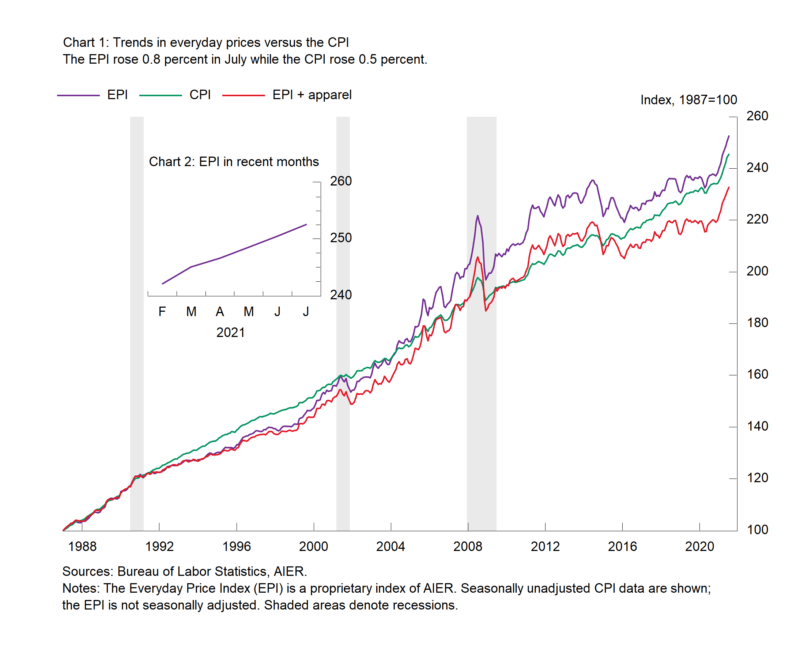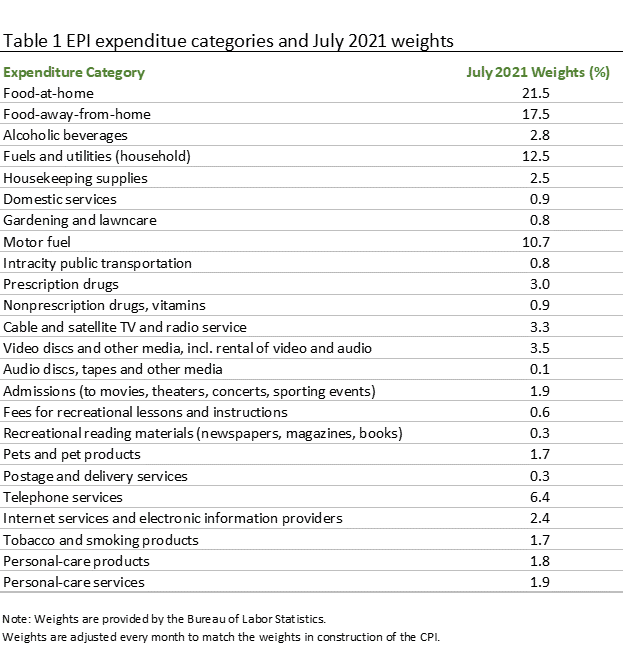Everyday Price Index Outpaces the CPI in July
The AIER Everyday Price Index increased by 0.8 percent in July, the third consecutive increase of that size and the eighth month in a row with a gain of at least 0.5 percent. The most recent rise puts the 12-month gain at 6.4 percent, the fourth month in a row above 6 percent. The last time the Everyday Price Index posted four consecutive 12-month gains above six percent was July through October 2011.
The positive contributions were more widespread in July but were still led by increases in food and energy categories. The largest contributors to the July increase in the Everyday Price Index were motor fuels prices, up 2.5 percent and contributing 27 basis points, food away from home (a.k.a. restaurants, up 0.8 percent for the month and contributing 14 basis points), food at home (a.k.a. groceries, up 0.6 percent and also adding 14 basis points), and household fuels and utilities (up 0.7 percent for the month and contributing 9 basis points). Positive contributions also came from personal care services (0.4 basis points), housekeeping supplies, pets and pet products, and admissions to movies, theaters, concerts, and sporting events, etc. (each adding 3 basis points), and cable and satellite television and radio service (adding 2 basis points).
The Everyday Price Index including apparel, a broader measure that includes clothing and shoes, rose 0.7 percent for the third consecutive month and is also the eighth consecutive increase. Over the past year, the Everyday Price Index including apparel is up 6.3 percent, the third month in a row above 6 percent. Apparel prices fell 1.0 percent on a not-seasonally-adjusted basis in July, the third fall in the last four months and sixth drop over the past ten months. From a year ago, apparel prices are up 4.2 percent.
The Consumer Price Index, which includes everyday purchases as well as infrequently purchased, big-ticket items and contractually fixed items, rose 0.5 percent on a not-seasonally-adjusted basis in July. Over the past year, the Consumer Price Index is up 5.4 percent, the same as in June and equaling the fastest pace since August 2008.
The Consumer Price Index excluding food and energy rose 0.3 percent for the month (not seasonally adjusted) while the 12-month change came in at 4.3 percent, down from 4.5 percent in June. The 12-month change in the core CPI was just 1.3 percent in February.
After seasonal adjustment, the CPI rose 0.5 percent in July while the core increased 0.3 percent for the month. Within the core, core goods prices were up 0.5 percent in July and are up 8.5 percent from a year ago while core services prices rose 0.3 percent for the month and are up 2.9 percent from a year ago.
Among the notable increases in the core CPI were new vehicles (up 1.7 percent in July and 6.4 percent from a year ago), and tobacco and smoking products (up 0.5 percent for the month and 6.4 percent from a year ago). Used car and truck prices gained 0.2 percent for the month, much slower than the 10.5 percent surge in June. Over the past year, used car and truck prices have increased 41.7 percent.
Among core services, gainers include lodging away from home including hotels and motels (up 6.0 percent in July) and motor vehicle repair services (2.0 percent).
Prices for many goods and services in the economy continue to be distorted by lingering effects from government restrictions on consumers and businesses including shortages, logistical and supply chain issues, and labor problems. As activity returns to normal, supply and demand will adapt and likely lead to slower price increases, but it may take some time before the economy completely returns to normal functioning. Nevertheless, a 1970s-style upward price spiral remains unlikely.
Note: The Everyday Price Index for June is based on incomplete data due to restrictions on data collection by Bureau of Labor Statistics personnel because of the Covid-19 pandemic.







